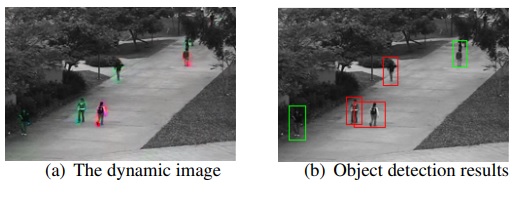Anomaly Detection in Surveillance Videos through Object-Oriented Analysis
DOI:
https://doi.org/10.63876/ijss.v1i1.7Keywords:
Surveillance videos, Object detection, Tracking, Anomaly detectionAbstract
Detecting and pinpointing irregularities in surveillance videos has remained a persistent challenge. The current approaches, which are based on patches or trajectories, do not have a semantic understanding of the scenes and may split the targets into fragments. To address this issue, this research proposes a new and efficient algorithm that combines deep object detection and tracking, while fully leveraging spatial and temporal information. A dynamic image is introduced by integrating both appearance and motion information and then fed into an object detection network, which accurately detects and classifies objects, even in crowded and poorly lit scenes. Based on the detected objects, an effective and scale-insensitive feature, named Histogram Variance of Optical Flow Angle (HVOFA), is developed together with motion energy to identify abnormal motion patterns. To further detect missing anomalies and reduce false detections, a post-processing step is carried out with abnormal object tracking. This algorithm outperforms existing methods on established benchmarks.
Downloads
References
Vijay Mahadevan, Weixin Li, Viral Bhalodia, and Nuno Vasconcelos, “Anomaly detection in crowded scenes,” in CVPR. IEEE, 2010, pp. 1975–1981.
[2] Yachuang Feng, Yuan Yuan, and Xiaoqiang Lu, “Learn ing deep event models for crowd anomaly detection,” Neurocomputing, vol. 219, pp. 548–556, 2017.
[3] Asimenia Dimokranitou, Adversarial Autoencoders for Anomalous Event Detection in Images, Ph.D. thesis, Purdue University, 2017.
[4] Borislav Antic and Bj ´ orn Ommer, “Video parsing for ¨ abnormality detection,” in ICCV. IEEE, 2011, pp. 2415–2422.
[5] Jefferson Ryan Medel and Andreas Savakis, “Anomaly detection in video using predictive convolutional long short-term memory networks,” arXiv preprint arXiv:1612.00390, 2016.
[6] Roberto Leyva, Victor Sanchez, and Chang-Tsun Li, “Video anomaly detection with compact feature sets for online performance,” TIP, 2017.
[7] Serhan Cos¸ar, Giuseppe Donatiello, Vania Bogorny, Carolina Garate, Luis Otavio Alvares, and Franc¸ois Bremond, “Toward abnormal trajectory and event detection in video surveillance,” TCSVT, vol. 27, no. 3,pp. 683–695, 2017.
Navneet Dalal and Bill Triggs, “Histograms of oriented gradients for human detection,” in CVPR. IEEE, 2005, vol. 1, pp. 886–893.
Navneet Dalal, Bill Triggs, and Cordelia Schmid, “Hu man detection using oriented histograms of flow and ap pearance,” in ECCV. Springer, 2006, pp. 428–441.
Tan Xiao, Chao Zhang, and Hongbin Zha, “Learning to detect anomalies in surveillance video,” IEEE Signal Processing Letters, vol. 22, no. 9, pp. 1477–1481, 2015.
Mohammad Sabokrou, Mahmood Fathy, Mojtaba Ho seini, and Reinhard Klette, “Real-time anomaly de tection and localization in crowded scenes,” in CVPR, 2015, pp. 56–62.
Dan Xu, Yan Yan, Elisa Ricci, and Nicu Sebe, “Detect ing anomalous events in videos by learning deep repre sentations of appearance and motion,” CVIU, vol. 156, pp. 117–127, 2017.
Mohammad Sabokrou, Mohsen Fayyaz, Mahmood Fathy, and Reinhard Klette, “Deep-cascade: Cascad ing 3d deep neural networks for fast anomaly detection and localization in crowded scenes,” TIP, vol. 26, no. 4, pp. 1992–2004, 2017.
Ke Ma, Michael Doescher, and Christopher Bodden,“Anomaly detection in crowded scenes using dense tra jectories,” .
Claudio Piciarelli and Gian Luca Foresti, “On-line tra jectory clustering for anomalous events detection,” Pat tern Recognition Letters, vol. 27, no. 15, pp. 1835–1842, 2006.
Jifeng Dai, Yi Li, Kaiming He, and Jian Sun, “R-fcn: Object detection via region-based fully convolutional networks,” in NIPS, 2016, pp. 379–387.
Ziping Zhu, Jingjing Wang, and Nenghai Yu, “Anomaly detection via 3d-hof and fast double sparse representa tion,” in ICIP. IEEE, 2016, pp. 286–290.
John Wright, Arvind Ganesh, Shankar Rao, Yigang Peng, and Yi Ma, “Robust principal component anal ysis: Exact recovery of corrupted low-rank matrices via convex optimization,” in NIPS, 2009, pp. 2080–2088.
Qiankun Liu, Bin Liu, and Nenghai Yu, “Tccf: Tracking based on convolutional neural network and correlation filters,” in ICIG. Springer, 2017.
Ying Zhang, Huchuan Lu, Lihe Zhang, and Xiang Ruan, “Combining motion and appearance cues for anomaly detection,” Pattern Recognition, vol. 51, pp. 443–452, 2016.
Yang Cong, Junsong Yuan, and Ji Liu, “Abnormal event detection in crowded scenes using sparse representa tion,” Pattern Recognition, vol. 46, no. 7, pp. 1851–1864, 2013.
Weixin Luo, Wen Liu, and Shenghua Gao, “A revisit of sparse coding based anomaly detection in stacked rnn framework,” ICCV, Oct, 2017.











